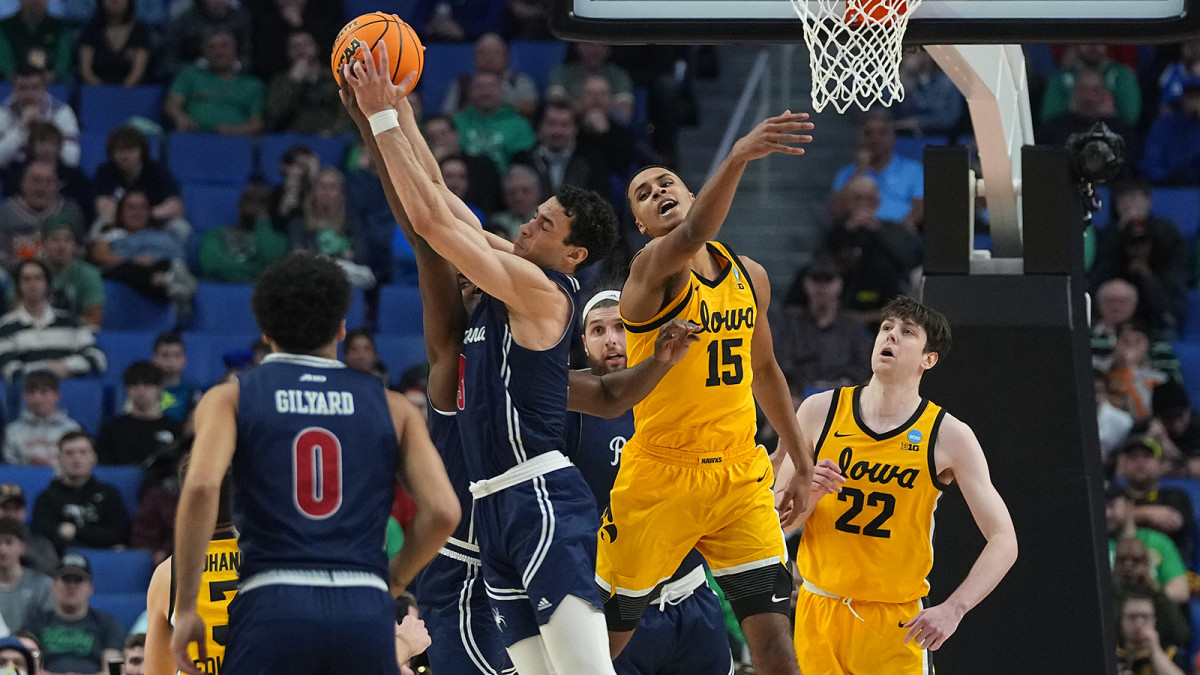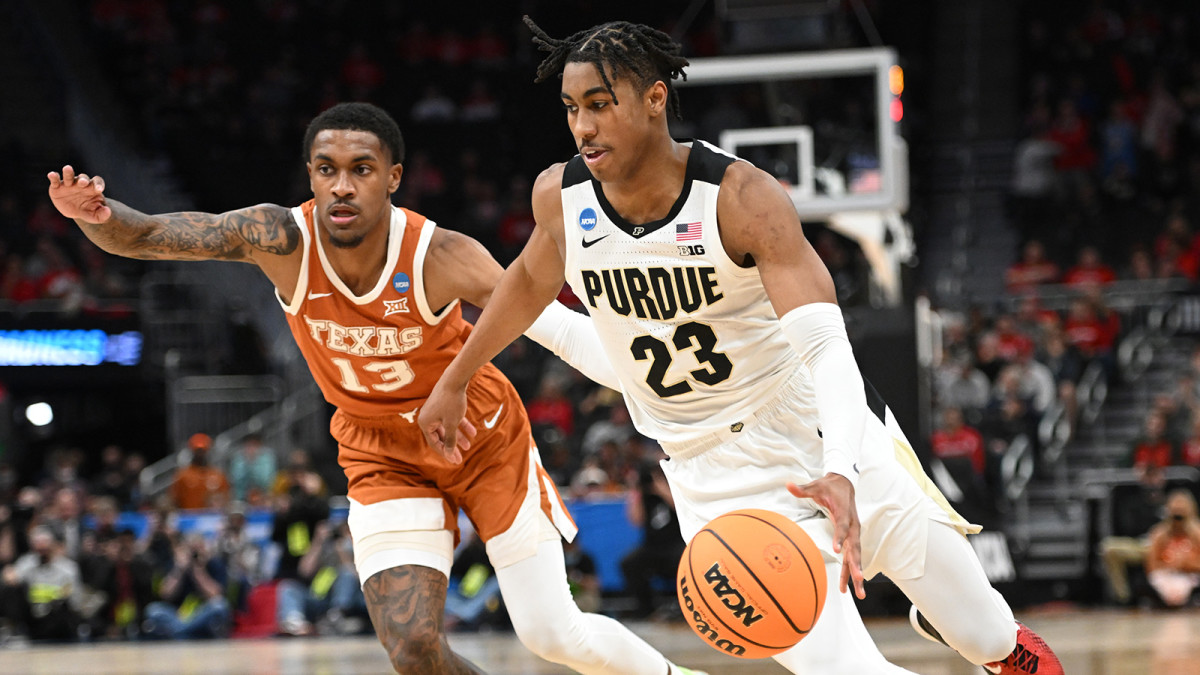Big Ten Faces Scrutiny After Another Suboptimal Men’s First Weekend
MILWAUKEE — After briefly accelerating toward the rim with a lengthy stride, giving the fans, players and pearl-clutchers something to imagine (and to be sure, up 10 points on Texas, a vicious breakaway dunk just might have been unnecessary), Jaden Ivey and his better angels dribbled out the clock instead. He glanced over at a raucous Purdue team with a grin as time expired: His highlight reel needed no last-minute insertions.
On the other end of the same Fiserv Forum court some two-plus hours earlier, Ivey’s Wisconsin counterpart, Johnny Davis, took a minute to compose himself before joining the handshake line, his chin nestled in his left palm as he soaked in the moment. An exceedingly friendly and well-oiled crowd in the stands looked on in disbelief, as their Badgers had not been as fortunate. In a mucky contest marred by an ankle injury to dependable point guard Chucky Hepburn, Wisconsin fell to Iowa State by five, grasping for answers off the bench with a permanent wrench in a creaky offensive attack.
There was a degree of cosmic synchronicity to Sunday night’s events, as the Big Ten’s torch-bearing teams and two highest seeds, led by their must-see, NBA-bound sophomore guards, made disparate exits from Milwaukee. Purdue went on its way to Philadelphia with tangible Final Four dreams, and Wisconsin, the regular season co-champion, hopped a short bus ride back to Madison. This concluded an uneven weekend for the league on whole: Of the Big Ten’s nine teams that cracked the tournament’s field of 68, just two remained in the dance-off. No. 11 seed Michigan swung upsets over Colorado State and Tennessee, and the Boilermakers held their seed against Texas and Yale. Prior to Wisconsin’s heartbreak, earlier in the day, Illinois (the other co-champion), Ohio State and Michigan State had also fallen, joining Iowa (the conference tourney champ), Indiana and Rutgers among the vanquished.

Most of the time, the hemming and hawing over which conferences are superior leads to relatively meaningless arguments. NCAA tournament performance, however, can at least be measured by the simple criteria of who has the fortune to survive and advance. It could be worse: Only one of the SEC’s six tourney teams, Arkansas, is still standing, and the other five all lost to double-digit seeds. But a year ago, the Big Ten sent only Michigan (out of its nine bids) to the second weekend of a tourney played entirely on relative home turf in the state of Indiana.
Of course, there was no tournament in 2020, but the last time a Big Ten team made the Final Four was 2019, when Michigan State was promptly handled by Texas Tech. The Spartans are also the league’s most recent champions, having reigned in the year 2000, which, if it really needed to be spelled out, happened nearly 22 years ago. For more context, the vast majority of the conference’s current players hadn’t even been born yet (one exception being Wisconsin’s fifth-year senior Brad Davison, who celebrated his first a few weeks after Tom Izzo hoisted that trophy).
Davison’s college career also ended here on Sunday, in a game that felt less like a true indictment of Wisconsin and more the final link in a difficult chain of circumstance. Johnny Davis would never admit it, and neither did Wisconsin coach Greg Gard, but the Badgers’ star was visibly less than his best self—he’d been hobbled by minor injuries all season, most recently a nasty left ankle sprain in the final regular-season game against Nebraska. He shot 4-of-16 and missed his seven three-point attempts, contributing to his team’s poor 29% shooting.
Those offensive issues were compounded by Hepburn’s injury, which thrust several little-used bench players into action, including Jahcobi Neath (who missed his three field goal attempts), Jordan Davis (Johnny’s twin brother, who saw double-digit minutes just six times all season) and Isaac Lindsey, a preferred walk-on who played 13 minutes this year and transferred from UNLV, where he’d been recruited by now Iowa State coach T.J. Otzelberger. Depth is something coaches can cultivate over time, but sudden injury can’t truly be prepared for—and surely, not all of the blame can be foisted onto Gard.

It’s tougher to formulate excuses for some of the Big Ten’s other top teams: Five-seed Iowa’s first-round loss to Richmond rings particularly frustrating due to the presence of star Keegan Murray, who had an individual season on par with that of Luka Garza last year, but couldn’t do the heavy lifting alone. No. 4 Illinois nearly lost to No. 13 seed Chattanooga before Houston thoroughly outplayed the Illini on Sunday afternoon. Ohio State took a respectable loss to No. 2 Villanova, but had limped into the tourney with four losses in five games. It was hard to expect a whole lot from anyone else, and Michigan State held ground in pushing No. 2 Duke to the brink. But in a year when the conference was loaded with star power, it’s inarguably disappointing to see so many of them fall by the wayside, with Davis, Murray, Kofi Cockburn and E.J. Liddell among those longer dancing.
Say what you want about Hunter Dickinson and his smug theatrics, but he’s scored 48 points in two games, and Michigan, clearly tourney-worthy, remains. The Wolverines have been a curious case, snaring a No. 11 seed after alternating wins and losses for the entire final month of the season. Coach Juwan Howard drew heavy scrutiny after escalating a now-infamous postgame scuffle with Wisconsin on Feb. 20. Let us all remember that Howard can, in fact, coach, after orchestrating a defensive masterclass against Colorado State, but also that extreme variance can happen to anyone, after Tennessee made just two of 18 threes as it fell to Michigan on Saturday. The Wolverines now draw a much older Villanova team that led Ohio State for the entire 40 minutes on Sunday, and a win would lead to an undesirable matchup with Arizona or Houston.
The best hope for the Big Ten to plant its flag at the Final Four has probably always been Purdue: Its occasionally leaky defense has looked like a yellow flag for prognosticators but held Yale to 56 points and mostly prevented Texas from working the ball inside. Purdue and its three best players create unique and constant problems for the opposition. Ivey comes off two of his most focused efforts of the season: He attacked with controlled aggression on his way to making 15 of 18 combined free throw attempts against Yale and Texas and maintaining a hot hand from three, where he shot 5-for-10 on the weekend. His defensive effort has been a valid point of scrutiny, but has redoubled, underscored by a breakneck first-half chase-down block on Texas’s Courtney Ramey that effectively erased Ivey’s own turnover. The 20-year-old sophomore was poised in draining a pair of late-game threes that extended Purdue’s reach.

Sunday’s win was equally spurred by Purdue’s all-time gigantic and effectively brawny center platoon of 7'4" Zach Edey and 6'10" Trevion Williams, the former absorbing the punishment on his way to 12 free throw attempts, and the latter scoring 22 points on 13 shots with an array of post moves. Texas committed 29 team fouls, and starting bigs Christian Bishop and Timmy Allen both fouled out. When opponents opt to crowd the perimeter, Purdue is comfortable throwing the ball inside. “If you want to stay one on one and you can defend us, then that really helps you,” said coach Matt Painter. “But if you can't defend us and you're going to draw fouls, we're obviously going to really get into your bench like we did today.”
The Boilermakers are now the top remaining seed in an eminently winnable region whose No. 1 seed (Baylor) and No. 2 seed (Kentucky) were already ousted. They enter this week heavily favored against plucky No. 15 seed Saint Peter’s, which stunned John Calipari’s Wildcats and followed with a win over solid No. 7 seed Murray State. On the other side lies tough-but-beatable North Carolina, which nearly blew a 25-point lead to Baylor, and UCLA, which may be without top player Jaime Jaquez Jr., who injured his ankle Saturday. These are quality teams, but glancing around the bracket, the pathway to New Orleans feels relatively enviable in what’s been a rough-and-tumble tournament.
The seeds sure haven’t mattered much, but for what it’s worth, there are three Big 12 teams, three ACC teams and two Pac-12 teams left. But caring about any of that is certainly not a prerequisite to enjoying the basketball that remains. There are all sorts of theories swirling about why the Big Ten hasn’t delivered on its reputation in recent years. Frankly, it’s really hard to win games in the tournament. But for a league that’s been held in high enough esteem to pace the country with nine bids in consecutive seasons, the matter of results, frankly, matters. To be fair, at this point, Purdue and Michigan both making the Final Four wouldn’t have a direct bearing on the conference’s macro-level scrutiny—that part’s already happening. But, say, the Boilermakers slip up against Saint Peter’s? Well, it can always be worse.
More March Madness Coverage:
• The ACC Showed Up to Dance
• ‘Drew Timme Effect’ Kicks in at Right Time for Gonzaga
• Michigan Finds Consistency to Halt Red-Hot Tennessee
• Creighton Clark, Iowa to Seal ‘Storybook’ Win
